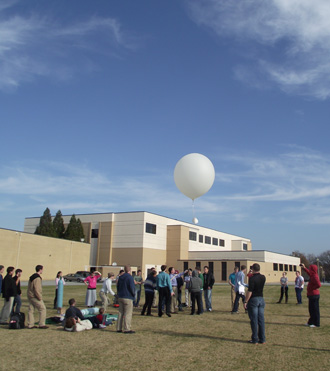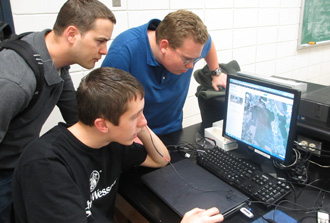Freshman Engineering Students Reach for the Stratosphere
A small crowd of engineering students and their faculty gathered Saturday morning, Dec. 1, on stadium field—but they weren’t there to play soccer. They were there to launch three weather balloons equipped with cameras and other instrumentation into the stratosphere.
The launch was part of the final project of the semester for Eng 101 Introduction to Engineering, BJU’s freshman-level engineering course. The goal of the project was to launch a balloon with a payload of electronics, capture data (in this case, still photos or video) and track the balloon throughout its entire flight.
The Process
 For the 39 students in the class, launch day was the culmination of months of research, collaboration and hard work. “The most exciting part of the whole project would have to be the launch day events,” says Daniel Belville, a freshman from New Hampshire. “It was the day that all of our hard work had come together, and it was being put to the test.”
For the 39 students in the class, launch day was the culmination of months of research, collaboration and hard work. “The most exciting part of the whole project would have to be the launch day events,” says Daniel Belville, a freshman from New Hampshire. “It was the day that all of our hard work had come together, and it was being put to the test.”
Teams
That hard work began halfway through the semester when students were divided into three teams: A, B and C. Each team had to launch a balloon but was given a different goal to focus on. Team A’s goal was to retrieve the highest quality data. Team B, on the other hand, was responsible for ensuring the highest probability of recovering their payload. Team C’s goal was to emphasize the performance of their balloon by achieving the highest possible altitude.
Based on these criteria, each team researched the best way to accomplish its goal, proposed a plan, built the payload, tested it and launched it. “With this project, I was able to experience the entire engineering process from brainstorming to optimization while learning to interact with my fellow classmates,” says James Reynolds, a freshman from North Carolina on Team B. “It was exciting to develop a plan on paper that actually became reality.”
Groups
 Each team was further broken down into four groups, and each group was responsible for a different part of the project. For example, one group was in charge of the balloon and the parachute. Another was responsible for ensuring the payload could survive the extreme temperatures of the stratosphere or a variety of other factors, such as a water landing.
Each team was further broken down into four groups, and each group was responsible for a different part of the project. For example, one group was in charge of the balloon and the parachute. Another was responsible for ensuring the payload could survive the extreme temperatures of the stratosphere or a variety of other factors, such as a water landing.
The goal of this team structure is to teach students the importance of collaboration and teamwork in engineering. “Engineering requires teamwork to solve problems,” says junior engineering student Justin Crews, who functioned as a project manager for Team B. “I know now that biblical engineering requires teamwork to help man glorify God.”
The Challenges

Division of Natural Science
One of the primary benefits of collaboration is the ability to leverage the team’s collective creativity to confront challenges and implement solutions.
One of the biggest challenges the teams had to overcome was implementing a live tracking system in the balloons’ payloads. The most common solution to this problem for amateur balloonists is to use a GPS-enabled cell phone. However, the Federal Communications Commission forbids use of typical mobile phones on any aircraft, including balloons. On top of that, a cell phone would lose service above 10,000 feet, which would prevent live tracking for most of the flight.
The students had to creatively work around this limitation, says Dr. Patrick McGary, the professor of Eng 101. “Part of the whole point of the class is that you have to be creative to work within constraints,” he says. “Constraints are not your enemy. In fact constraints help you to find the design.”
The teams solved this problem by using an amateur radio system that could convert the radio transmissions into digital data packets. This data could then be fed into Google Earth, where the teams could track temperature and the balloon’s speed, altitude and location.
The Flight and Recovery
Of the three balloons, Team C’s reached the highest speed at 143 mph. It also achieved the highest altitude at 109,880 feet (more than 20 miles), where it captured stunning images of the earth’s curvature against the blackness of space.
But what goes up must come down. At high altitudes the helium inside the balloon eventually expands and bursts the balloon. The payload is then dropped and a parachute deploys to guide it gently back to earth.
The fact that the payload will come down is certain, but where it comes down is a completely different story. The teams did their best to predict an approximate landing location based on weather models, the amount of helium in the balloon and a number of other factors, but no amount of research can predict an exact landing location.
 That’s where the tracking system comes into play. Sadly, Team A’s payload stopped transmitting during the flight. However, the good-old-fashioned note and phone number taped to the side of the payload saved the day, and it was recovered after someone found it and called the team.
That’s where the tracking system comes into play. Sadly, Team A’s payload stopped transmitting during the flight. However, the good-old-fashioned note and phone number taped to the side of the payload saved the day, and it was recovered after someone found it and called the team.
Team B’s also stopped transmitting, and its payload was similarly recovered in January. Team C’s payload made a safe landing in a North Carolina field where it transmitted its location to a recovery team.
The Big Picture

While launching weather balloons is quite common among hobbyists and precollege engineering projects, BJU’s freshman engineering class took the project to a whole new level in their collaboration, research and instrumentation. But the most significant feat was the live tracking system.
From here these engineering students will continue to develop their skills and eventually apply them to bigger and better projects. By their senior years, they will compete in autonomous robot competitions, develop individual projects and participate in a number of group projects.
One recent group project was to create a stream-powered generator that is awaiting installation by missionaries in Papua New Guinea. One of the most exciting areas of undergraduate research currently happening is with single-camera stereo vision.
Eng 101 serves to get students excited about the field of engineering, teach them the basics in a fun and practical way, and connect them with other students in their major.
“I would have to say that the biggest plus of this class would be that I got to see what it was like to work in small groups of a big team for the benefit of the whole team,” says Quentin Ames, a freshman from New Hampshire. “All in all, this project has really solidified my resolve to continue pursuing this major and become an engineer someday.”